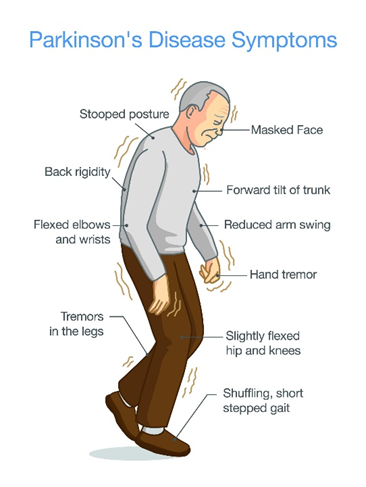Parkinson's disease has which characteristic symptom(s)? SELECT ALL THAT APPLY
Muscle tremors
Slow body movement (bradykinesia)
Rigidity
Pill rolling
Lack of facial expression
Drooling
Correct Answer : A,B,C,D,E,F
A. Muscle tremors:
Muscle tremors, particularly resting tremors, are a hallmark feature of Parkinson's disease. These tremors typically occur in the hands, fingers, arms, legs, jaw, or head and may worsen with stress or inactivity.
B. Slow body movement (bradykinesia):
Bradykinesia refers to slowness of movement and is another key symptom of Parkinson's disease. Patients may have difficulty initiating movement, experience a decrease in spontaneous movement (hypokinesia), and demonstrate reduced range of motion.
C. Rigidity:
Rigidity, or stiffness of the muscles, is a common symptom of Parkinson's disease. It often affects the limbs and trunk and can contribute to difficulty with movement and posture.
D. Pill rolling:
Pill rolling refers to a specific type of tremor characterized by rhythmic, rolling movements of the thumb and fingers, resembling the action of rolling a pill between the fingers and thumb. This tremor is commonly seen in Parkinson's disease.
E. Lack of facial expression:
Parkinson's disease can lead to a reduced range of facial expressions, also known as hypomimia or "masked facies." Patients may have a fixed, expressionless facial appearance and reduced blinking.
F. Drooling:
Drooling, or excessive salivation, can occur in Parkinson's disease due to impaired swallowing function (dysphagia) and reduced control over oral and facial muscles.

Nursing Test Bank
Naxlex Comprehensive Predictor Exams
Related Questions
Correct Answer is C
Explanation
A. Lhermitte's sign:
Lhermitte's sign is a neurological symptom characterized by a sensation of electric shock-like pain that radiates down the spine and into the limbs, typically triggered by flexing the neck forward. It is often described as shooting or stabbing pain and is commonly associated with lesions or damage to the cervical spinal cord. Lhermitte's sign is not associated with a tightening sensation around the torso but rather with shooting pain down the spine and limbs.
B. Trigeminal neuralgia:
Trigeminal neuralgia is a neurological condition characterized by severe, shooting pain along the trigeminal nerve, which supplies sensation to the face. The pain is typically triggered by activities such as chewing, speaking, or touching the face. Trigeminal neuralgia causes sudden, intense, electric shock-like pain in the face, particularly in the areas supplied by the trigeminal nerve (e.g., cheek, jaw, forehead). It is not associated with a tightening sensation around the torso.
C. MS hug:
The "MS hug" is a symptom experienced by some individuals with multiple sclerosis, characterized by a sensation of tightness, pressure, or squeezing around the chest, abdomen, or torso. It can feel like a band tightening around the body and may be described as a constricting or girdling sensation. The MS hug is caused by spasms or tightening of the muscles surrounding the rib cage or the intercostal muscles due to damage to the nerves that control muscle function in MS.
D. Paroxysmal spasms:
Paroxysmal spasms refer to sudden, involuntary muscle contractions or spasms that occur intermittently. These spasms can affect various parts of the body and are commonly associated with conditions like multiple sclerosis. However, they typically present as brief, sudden contractions rather than a persistent tightening sensation around the torso.
Correct Answer is ["0.6"]
Explanation
To calculate the dose of diazepam in mL, the nurse should use the formula:
Dose (mL) = Desired dose (mg) / Available dose (mg/mL)
Plugging in the values from the question, we get:
Dose (mL) = 3 mg / 5 mg/mL
Simplifying, we get:
Dose (mL) = 0.6 mL
Therefore, the nurse should administer 0.6 mL of diazepam IM.
Whether you are a student looking to ace your exams or a practicing nurse seeking to enhance your expertise , our nursing education contents will empower you with the confidence and competence to make a difference in the lives of patients and become a respected leader in the healthcare field.
Visit Naxlex, invest in your future and unlock endless possibilities with our unparalleled nursing education contents today
Report Wrong Answer on the Current Question
Do you disagree with the answer? If yes, what is your expected answer? Explain.
Kindly be descriptive with the issue you are facing.
